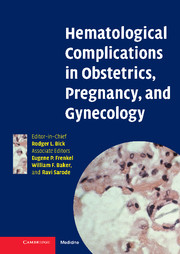Book contents
- Frontmatter
- Contents
- List of contributors
- Preface
- 1 Disseminated intravascular coagulation in obstetrics, pregnancy, and gynecology: Criteria for diagnosis and management
- 2 Recurrent miscarriage syndrome and infertility caused by blood coagulation protein/platelet defects
- 3 Von Willebrand disease and other bleeding disorders in obstetrics
- 4 Hemolytic disease of the fetus and newborn caused by ABO, Rhesus, and other blood group alloantibodies
- 5 Hereditary and acquired thrombophilia in pregnancy
- 6 Thromboprophylaxis and treatment of thrombosis in pregnancy
- 7 Diagnosis of deep vein thrombosis and pulmonary embolism in pregnancy
- 8 Hemorrhagic and thrombotic lesions of the placenta
- 9 Iron deficiency, folate, and vitamin B12 deficiency in pregnancy, obstetrics, and gynecology
- 10 Thrombosis prophylaxis and risk factors for thrombosis in gynecologic oncology
- 11 Low molecular weight heparins in pregnancy
- 12 Post partum hemorrhage: Prevention, diagnosis, and management
- 13 Hemoglobinopathies in pregnancy
- 14 Genetic counseling and prenatal diagnosis
- 15 Thrombocytopenia in pregnancy
- 16 Neonatal immune thrombocytopenias
- 17 The rational use of blood and its components in obstetrical and gynecological bleeding complications
- 18 Heparin-induced thrombocytopenia in pregnancy
- 19 Coagulation defects as a cause for menstrual disorders
- Index
- Plate section
- References
4 - Hemolytic disease of the fetus and newborn caused by ABO, Rhesus, and other blood group alloantibodies
Published online by Cambridge University Press: 01 February 2010
- Frontmatter
- Contents
- List of contributors
- Preface
- 1 Disseminated intravascular coagulation in obstetrics, pregnancy, and gynecology: Criteria for diagnosis and management
- 2 Recurrent miscarriage syndrome and infertility caused by blood coagulation protein/platelet defects
- 3 Von Willebrand disease and other bleeding disorders in obstetrics
- 4 Hemolytic disease of the fetus and newborn caused by ABO, Rhesus, and other blood group alloantibodies
- 5 Hereditary and acquired thrombophilia in pregnancy
- 6 Thromboprophylaxis and treatment of thrombosis in pregnancy
- 7 Diagnosis of deep vein thrombosis and pulmonary embolism in pregnancy
- 8 Hemorrhagic and thrombotic lesions of the placenta
- 9 Iron deficiency, folate, and vitamin B12 deficiency in pregnancy, obstetrics, and gynecology
- 10 Thrombosis prophylaxis and risk factors for thrombosis in gynecologic oncology
- 11 Low molecular weight heparins in pregnancy
- 12 Post partum hemorrhage: Prevention, diagnosis, and management
- 13 Hemoglobinopathies in pregnancy
- 14 Genetic counseling and prenatal diagnosis
- 15 Thrombocytopenia in pregnancy
- 16 Neonatal immune thrombocytopenias
- 17 The rational use of blood and its components in obstetrical and gynecological bleeding complications
- 18 Heparin-induced thrombocytopenia in pregnancy
- 19 Coagulation defects as a cause for menstrual disorders
- Index
- Plate section
- References
Summary
Introduction
This chapter presents an overview of immune mediated hemolytic disease of the fetus and newborn (HDFN) due to ABO, Rh(D) and other red cell alloantibodies. Section I reviews the pathophysiology of immune mediated HDFN. Section II describes HDFN due to different antigen incompatibilities (ABO, Rh, and other antigens). Section III focuses on the management of the non-sensitized Rh(D) negative female, the alloimmunized mother, the fetus, and the neonate.
Section I: Pathophysiology of hemolytic disease of the fetus and neonate (HDFN)
The cause of hemolytic disease of the fetus and neonate (HDFN) is immune mediated destruction of fetal and/or newborn erythrocytes by maternal antibodies directed against fetal erythrocyte antigens inherited from the father. HDFN occurs as the result of five distinct events:
(1) Fetal inheritance of a paternal erythrocyte antigen
The gene for red cell antigen is inherited from the father. If the father is homozygous for the gene that the mother lacks, 100% of his offspring carry that gene and will be at the greatest risk for HDFN. The offspring of a heterozygous father will have 50% chance of carrying that gene and therefore will be at a lesser risk.
Passage of fetal erythrocytes into the maternal circulation exposes the pregnant female to the “foreign” paternal erythrocyte antigen
Any clinical situation that introduces the possibility of fetomaternal hemorrhage (FMH) may introduce fetal RBCs into maternal circulation and, thus, the possibility of maternal alloimmunization.
- Type
- Chapter
- Information
- Publisher: Cambridge University PressPrint publication year: 2006



